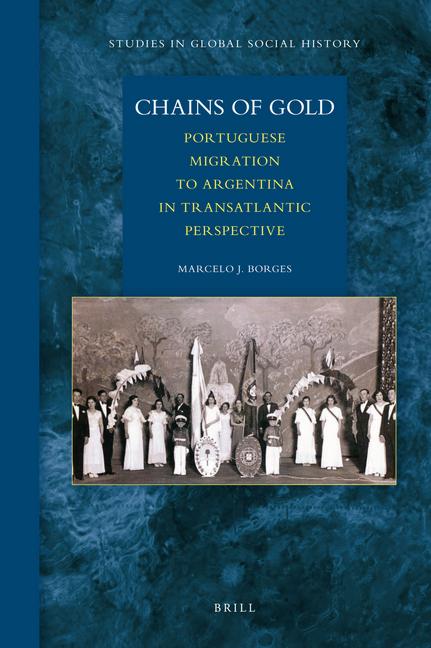
Zustellung: Di, 29.07. - Mo, 04.08.
Versand in 3-4 Wochen
VersandkostenfreiBestellen & in Filiale abholen:
Why did migrants from southern Portugal choose Argentina instead of following the traditional path to Brazil? Starting with this question, this book explores how, at the turn of the twentieth century, rural Europeans developed distinctive circuits of transatlantic labor migration linked to diverse immigrant communities in the Americas. It looks at transoceanic moves in the larger context of migration systems, examining their connections and the crucial role of social networks in migrants geographic mobility and adaptation. Combining regional and local perspectives on both sides of the Atlantic, Chains of Gold provides a vivid account of the trajectories of migrant men and women as they moved from rural Portugal to contrasting places of settlement in the Argentine pampas and Patagonia.
Inhaltsverzeichnis
List of Illustrations List of Maps, Tables and Figures Acknowledgements List of Abbreviations
1. Maria vai com as outras (Monkey See, Monkey Do) Portuguese Migration in Argentina Regional Flows and Local Networks Spatial Distribution and Immigrant Communities Approach
2. Migration in Context: Society, Economy, and Population in Rural Algarve The Land and Its Uses Rural Life and Migration in Two Algarvian Parishes Population and Space Economy Social Groups Domestic Groups Migration as a Family Strategy Demography and Emigration Conclusion
3. Regional Patterns of Migration: A Systems Approach Migration Systems A Systems Approach to Algarvian Migrations The Algarve and the Southern Iberia Migration System Gibraltar Southern Spain and Alentejo Other Circuits of Medium-distance Migration The Algarve and the Atlantic Migration System Causes, Continuities, and Changes Information and Perceptions Transatlantic Destinations Portuguese Africa: The Colonial Path Fazer a America: Destination Selection Conclusion
4. Chains of Gold: Migratory Networks in Two Portuguese Immigrant Communities Oil Camps and Suburban Gardens: Portuguese Migrants in Two Contrasting Receiving Societies Comodoro Rivadavia: The Making of an Oil Town Villa Elisa: From Bourgeois Retreat to Family Gardening The Dynamics of Chain Migration Forging the Chains: Origins and Social Spaces Phases: Pioneers, Migrant Workers, and Families Comodoro Rivadavia Villa Elisa Os esquecidos: The Broken Links of Chain Migration Chain Migration and Ethnic Middlemen Conclusion
5. Making a Living and Making a Life: Economic and Social Adaptation Making a Living Black El Dorado: Working in Comodoro Rivadavia Women and Work Gigantic Gardens of Flowers: Working in Villa Elisa A Family Affair: Generations and Gender Social Networks and Occupational Chains Making a Life: Marriage Patterns Old and New Social Ties Social and Ethnic Life Conclusion Bibliography and Sources Index
1. Maria vai com as outras (Monkey See, Monkey Do) Portuguese Migration in Argentina Regional Flows and Local Networks Spatial Distribution and Immigrant Communities Approach
2. Migration in Context: Society, Economy, and Population in Rural Algarve The Land and Its Uses Rural Life and Migration in Two Algarvian Parishes Population and Space Economy Social Groups Domestic Groups Migration as a Family Strategy Demography and Emigration Conclusion
3. Regional Patterns of Migration: A Systems Approach Migration Systems A Systems Approach to Algarvian Migrations The Algarve and the Southern Iberia Migration System Gibraltar Southern Spain and Alentejo Other Circuits of Medium-distance Migration The Algarve and the Atlantic Migration System Causes, Continuities, and Changes Information and Perceptions Transatlantic Destinations Portuguese Africa: The Colonial Path Fazer a America: Destination Selection Conclusion
4. Chains of Gold: Migratory Networks in Two Portuguese Immigrant Communities Oil Camps and Suburban Gardens: Portuguese Migrants in Two Contrasting Receiving Societies Comodoro Rivadavia: The Making of an Oil Town Villa Elisa: From Bourgeois Retreat to Family Gardening The Dynamics of Chain Migration Forging the Chains: Origins and Social Spaces Phases: Pioneers, Migrant Workers, and Families Comodoro Rivadavia Villa Elisa Os esquecidos: The Broken Links of Chain Migration Chain Migration and Ethnic Middlemen Conclusion
5. Making a Living and Making a Life: Economic and Social Adaptation Making a Living Black El Dorado: Working in Comodoro Rivadavia Women and Work Gigantic Gardens of Flowers: Working in Villa Elisa A Family Affair: Generations and Gender Social Networks and Occupational Chains Making a Life: Marriage Patterns Old and New Social Ties Social and Ethnic Life Conclusion Bibliography and Sources Index
Produktdetails
Erscheinungsdatum
02. Juni 2009
Sprache
englisch
Seitenanzahl
353
Autor/Autorin
Marcelo Borges
Verlag/Hersteller
Produktart
gebunden
Gewicht
757 g
Größe (L/B/H)
179/241/25 mm
ISBN
9789004176485
Bewertungen
0 Bewertungen
Es wurden noch keine Bewertungen abgegeben. Schreiben Sie die erste Bewertung zu "Chains of Gold" und helfen Sie damit anderen bei der Kaufentscheidung.









